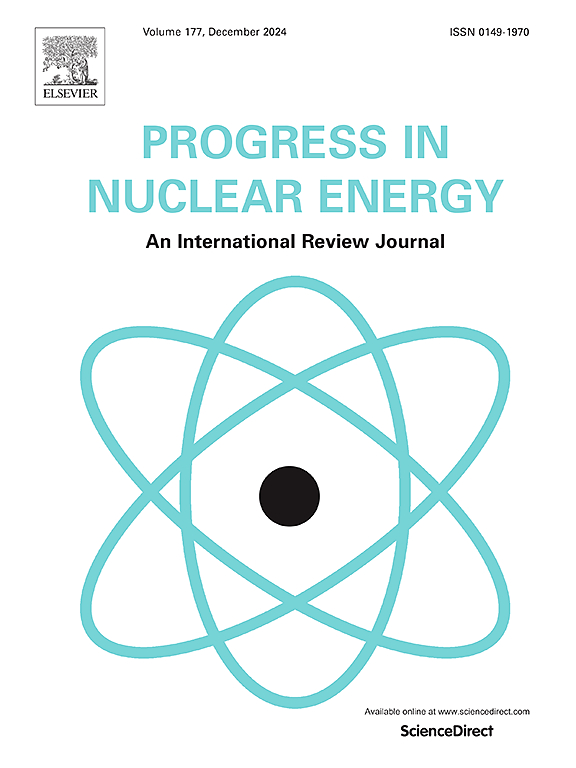n - 32b乏燃料演示桶精细建模与均匀建模方法的比较:第一部分——贮存条件
IF 3.2
3区 工程技术
Q1 NUCLEAR SCIENCE & TECHNOLOGY
引用次数: 0
摘要
由于乏燃料桶和罐建模的复杂性,通常采用均匀法(即将燃料区域建模为具有有效性质的多孔块)进行计算流体动力学模拟。该方法可以减少详细建模方法所需的计算量。然而,没有全面比较的均匀和详细的方法在一个完整的桶已在文献报道。在这篇第一部分的论文中,对tn - 32b乏燃料桶的详细模型与燃料组件的详细表示进行了比较,并将其与在储存条件下使用均匀方法的模型进行了比较。两种模型均使用相同的输入参数和计算网格。建立了径向和轴向的有效导热系数和多孔流动系数,并将其应用于均匀模型。从详细的和均匀的模型得到的温度和轴向速度在燃料区域内点对点的基础上进行比较。结果表明,均匀模型相对于精细模型准确地预测了温度,在燃料区域内较低海拔处观测到的差异最为显著。95%的燃料区温度数据在模型之间的2°C以内。此外,将两种模型获得的63个地点的温度与高燃耗示范项目的数据进行了比较,结果显示差异范围为- 7°C至+10°C。本文章由计算机程序翻译,如有差异,请以英文原文为准。
Comparison between detailed and homogenous modeling methods in the TN-32B spent nuclear fuel demo cask: Part I – storage conditions
Due to the complexity of modeling spent nuclear fuel casks and canisters, the homogenous method (i.e., modeling the fuel regions as porous blocks with effective properties) is often utilized to conduct computational fluid dynamics simulations. This method allows for reducing the computational effort required by the detailed modeling method. However, no comprehensive comparison between the homogenous and detailed methods in a full cask has been reported in the literature. In this Part I paper, a detailed model of the TN-32 B spent nuclear fuel cask with a detailed representation of the fuel assemblies is compared to a model that uses the homogenous method under storage conditions. The same input parameters and computational mesh are used in both models. Effective thermal conductivities and porous flow coefficients in the radial and axial directions are developed and applied to the homogenous model. Temperature and axial velocities obtained from the detailed and homogenous models are compared on a point-to-point basis within the fuel regions. The results indicate that the homogenous model accurately predicts temperatures relative to the detailed model, with the most notable differences observed at lower elevations within the fuel regions. 95 % of fuel region temperature data are within 2 °C between the models. Furthermore, temperatures at 63 locations obtained from both models are compared to data from the High Burnup Demonstration project and the results showed a difference ranging from −7 °C to +10 °C.
求助全文
通过发布文献求助,成功后即可免费获取论文全文。
去求助
来源期刊

Progress in Nuclear Energy
工程技术-核科学技术
CiteScore
5.30
自引率
14.80%
发文量
331
审稿时长
3.5 months
期刊介绍:
Progress in Nuclear Energy is an international review journal covering all aspects of nuclear science and engineering. In keeping with the maturity of nuclear power, articles on safety, siting and environmental problems are encouraged, as are those associated with economics and fuel management. However, basic physics and engineering will remain an important aspect of the editorial policy. Articles published are either of a review nature or present new material in more depth. They are aimed at researchers and technically-oriented managers working in the nuclear energy field.
Please note the following:
1) PNE seeks high quality research papers which are medium to long in length. Short research papers should be submitted to the journal Annals in Nuclear Energy.
2) PNE reserves the right to reject papers which are based solely on routine application of computer codes used to produce reactor designs or explain existing reactor phenomena. Such papers, although worthy, are best left as laboratory reports whereas Progress in Nuclear Energy seeks papers of originality, which are archival in nature, in the fields of mathematical and experimental nuclear technology, including fission, fusion (blanket physics, radiation damage), safety, materials aspects, economics, etc.
3) Review papers, which may occasionally be invited, are particularly sought by the journal in these fields.
 求助内容:
求助内容: 应助结果提醒方式:
应助结果提醒方式:


